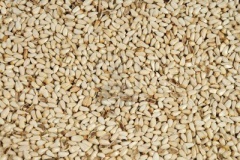Difference between revisions of "Safflower (seed)"
m |
|||
| Line 3: | Line 3: | ||
| origin = - | | origin = - | ||
| stowage factor = <ul><li>1,84 m<sup>3</sup>/t (bales)</li><li>1,64 m<sup>3</sup>/t (cases)</li> | | stowage factor = <ul><li>1,84 m<sup>3</sup>/t (bales)</li><li>1,64 m<sup>3</sup>/t (cases)</li> | ||
| − | | humidity and moisture = | + | | humidity and moisture = - |
| − | | ventilation = | + | | ventilation = - |
| − | | risk factors = | + | | risk factors = See text |
}} | }} | ||
| + | ==Desccription / Application== | ||
| + | Safflower is a highly branched, herbaceous, thistle-like annual. It is commercially cultivated for vegetable oil extracted from the [[seeds]]. [[Plants]] are 30 to 150 cm tall with globular flower heads having yellow, orange, or red flowers. Each branch will usually have from one to five flower heads containing 15 to 20 [[seeds]] per head. Safflower is native to arid environments having seasonal rain. It grows a deep taproot which enables it to thrive in such environments.<br><br> | ||
| + | Traditionally, the crop was grown for its [[seeds]], and used for colouring and flavouring foods, in medicines, and making red and yellow dyes, especially before cheaper [[aniline]] dyes became available. For the last fifty years or so, the plant has been cultivated mainly for the vegetable oil extracted from its [[seeds]]. <br><br> | ||
| + | Safflower seed oil is flavourless and colourless, and nutritionally similar to [[Sunflower Oil|sunflower oil]]. It is used mainly in cosmetics and as a cooking oil, in salad dressing, and for the production of [[margarine]]. It may also be taken as a nutritional supplement. <br><br> | ||
| + | Safflower seed is also used quite commonly as an alternative to [[sunflower]] seed in birdfeeders, as squirrels do not like the taste of it.<br><br> | ||
| + | There are two types of safflower that produce different kinds of oil: one high in monounsaturated fatty acid (oleic acid) and the other high in polyunsaturated fatty acid (linoleic acid). Currently the predominant edible oil market is for the former, which is lower in saturates than [[Olive Oil|olive oil]], for example. The latter is used in painting in the place of [[linseed oil]], particularly with white paints, as it does not have the yellow tint which [[linseed oil]] possesses.<br><br> | ||
| + | Safflower flowers are occasionally used in cooking as a cheaper substitute for saffron, and were thus often referred to as "bastard saffron" in earlier centuries.<br><br> | ||
| + | In colouring textiles, safflower's dried flowers are used as a natural textile dye. The pigment in safflower is the benzoquinone-derived chemical carthamin and it is classified as a quinone-type dye.<br><br> | ||
| + | Safflower concentrate is an ingredient of the carbonated soft drink Tizer and some types of Sunkist.<br><br> | ||
| + | ==Shipment / Storage / Risk factors== | ||
| + | Safflower is usually shipped in bales. The product is liable to damage by heating and moisture.<br><br> | ||
| + | |||
| + | See also [[Grain]] | ||
| + | |||
| + | [[Category: Products]] | ||
| + | [[Category: Seeds and agriproducts]] | ||
Revision as of 12:19, 4 August 2014
| Infobox on Safflower (seed) | |
|---|---|
| Example of Safflower (seed) |  |
| Facts | |
| Origin | - |
| Stowage factor (in m3/t) |
|
| Humidity / moisture | - |
| Ventilation | - |
| Risk factors | See text |
Safflower (seed)
Desccription / Application
Safflower is a highly branched, herbaceous, thistle-like annual. It is commercially cultivated for vegetable oil extracted from the seeds. Plants are 30 to 150 cm tall with globular flower heads having yellow, orange, or red flowers. Each branch will usually have from one to five flower heads containing 15 to 20 seeds per head. Safflower is native to arid environments having seasonal rain. It grows a deep taproot which enables it to thrive in such environments.
Traditionally, the crop was grown for its seeds, and used for colouring and flavouring foods, in medicines, and making red and yellow dyes, especially before cheaper aniline dyes became available. For the last fifty years or so, the plant has been cultivated mainly for the vegetable oil extracted from its seeds.
Safflower seed oil is flavourless and colourless, and nutritionally similar to sunflower oil. It is used mainly in cosmetics and as a cooking oil, in salad dressing, and for the production of margarine. It may also be taken as a nutritional supplement.
Safflower seed is also used quite commonly as an alternative to sunflower seed in birdfeeders, as squirrels do not like the taste of it.
There are two types of safflower that produce different kinds of oil: one high in monounsaturated fatty acid (oleic acid) and the other high in polyunsaturated fatty acid (linoleic acid). Currently the predominant edible oil market is for the former, which is lower in saturates than olive oil, for example. The latter is used in painting in the place of linseed oil, particularly with white paints, as it does not have the yellow tint which linseed oil possesses.
Safflower flowers are occasionally used in cooking as a cheaper substitute for saffron, and were thus often referred to as "bastard saffron" in earlier centuries.
In colouring textiles, safflower's dried flowers are used as a natural textile dye. The pigment in safflower is the benzoquinone-derived chemical carthamin and it is classified as a quinone-type dye.
Safflower concentrate is an ingredient of the carbonated soft drink Tizer and some types of Sunkist.
Shipment / Storage / Risk factors
Safflower is usually shipped in bales. The product is liable to damage by heating and moisture.
See also Grain











